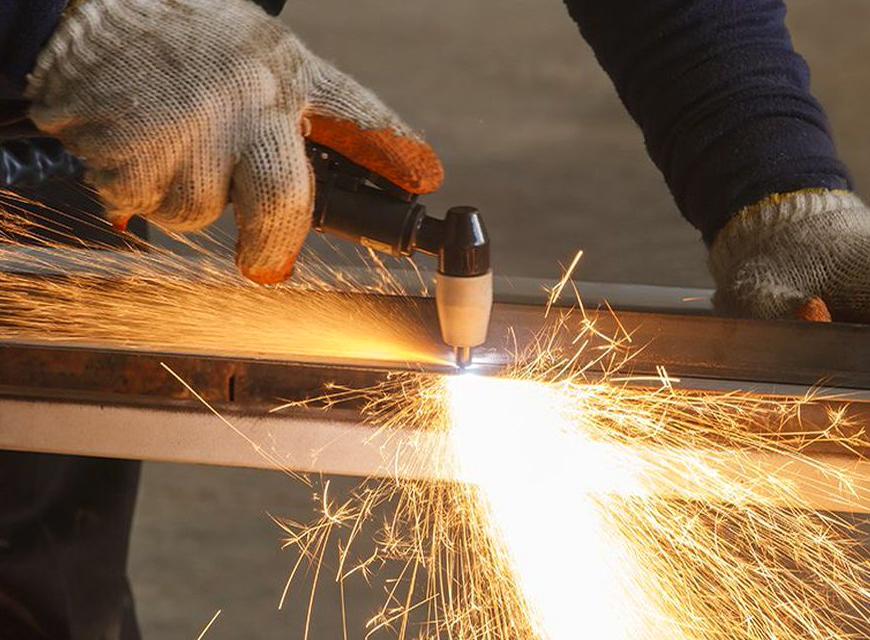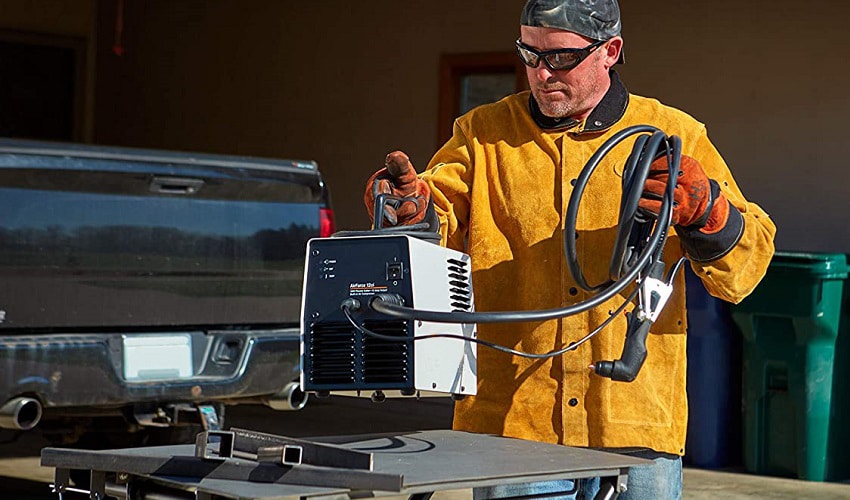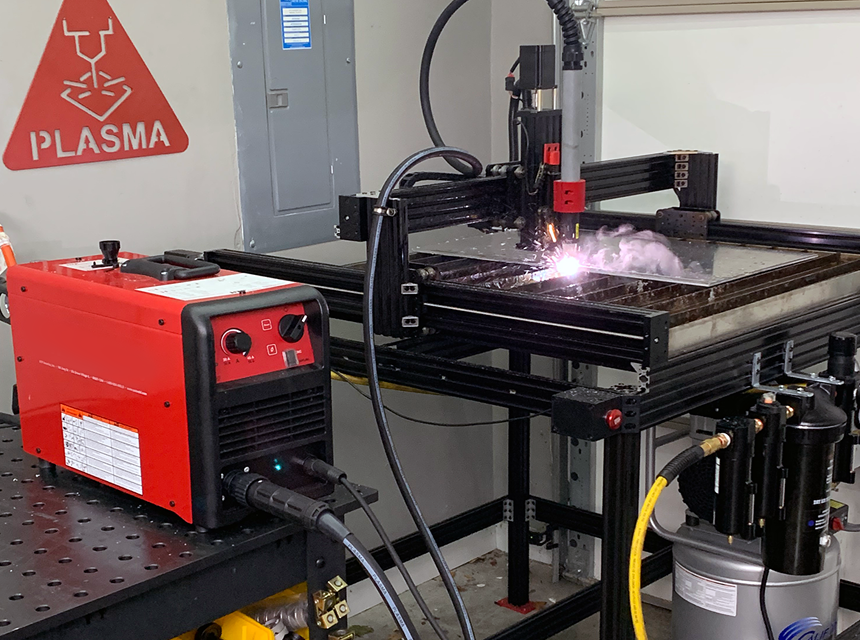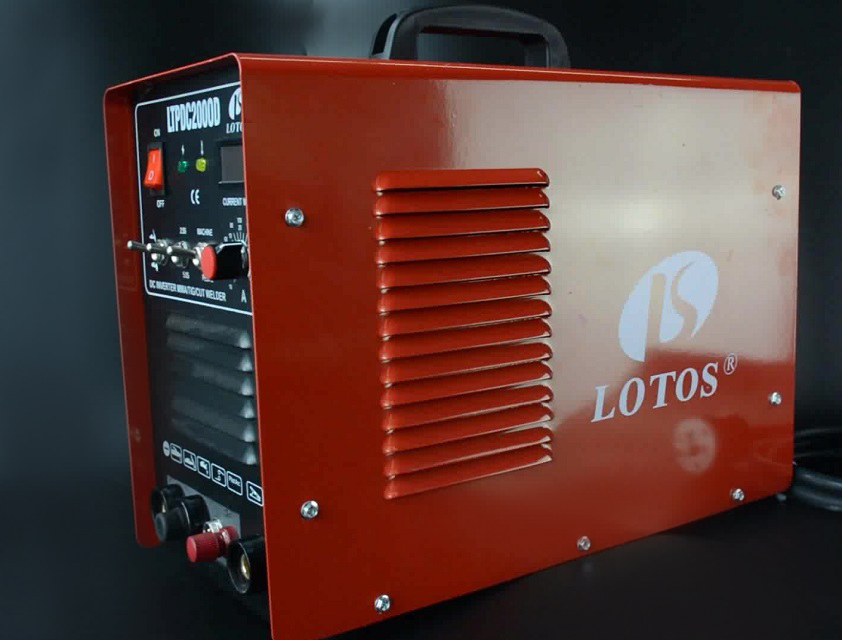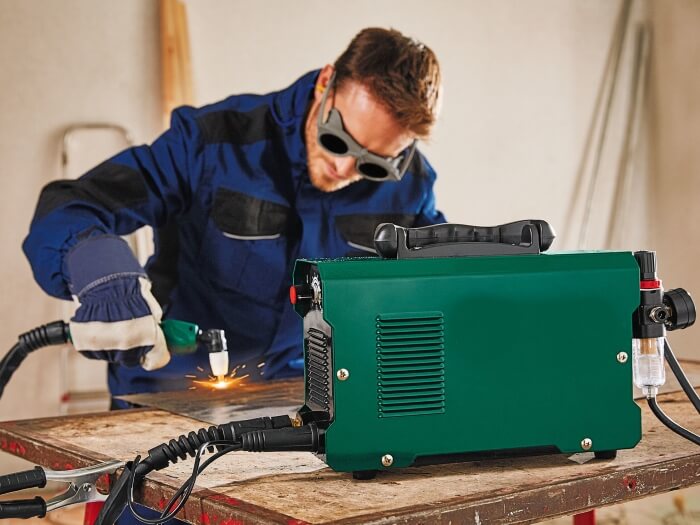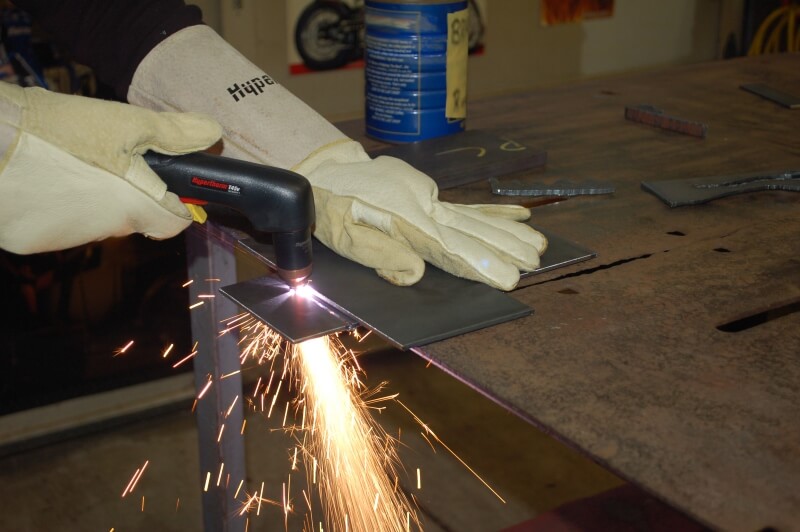

Most professional welders and DIYers who try out plasma cutting say they don’t want to go back to a traditional oxy-acetylene torch. If you’re still cutting with an old cutter for your metalworking projects, it’s time to upgrade to a plasma cutter. Thankfully, you don’t have to spend a fortune to make the switch – we’ve found eight of the best plasma cutters under $500.
We considered a number of factors in making our selection. We looked at cutting ability, which is a measure of how deep a cut a plasma cutter can make. We also consider weight and size, since portability is a huge advantage for plasma cutters over other types of torches. Another important factor we noted was the duty cycle, which can be critical if you use your plasma cutter for extended cuts. You’ll find all our picks plus detailed reviews below.
Other features: 50/60Hz; power supply and torch included; no assembly required; non-touch Pilot RC
The LTP5000D from Lotus is an incredibly high-quality plasma cutter for under $500. This cutter features Lotus’s pilot arc technology, which doesn’t require you to touch your torch tip to the metal you’re cutting. It can cut through painted and rusted metals easily without leaving slag behind. Plus, the torch is included with the plasma cutter.
This plasma cutter is relatively light duty and is best for home DIYers and contractors who occasionally need to cut through metal. It can run at either 110 or 220 volts, so it’s adaptable to any shop’s electrical setup. At 220 volts, you can cut metal sheets up to 0.5 inches cleanly. Users found that you can cut up to 0.75-inch-thick metal sheets, although the process is slow and leaves a kerf.
What we liked: One thing that we especially liked about this budget plasma cutter is that it’s easy to set up. There’s no assembly required when it arrives and it comes with a pre-installed NPT 0.25-inch D plug that works seamlessly with the stand coupler on almost any air compressor. So, just plug in your compressor and torch and you’re ready to get to work. Just keep in mind that the duty cycle is limited to 60%, so you’ll need to rest the unit between cuts.
What could be better: At 110 volts, you’re limited to a clean-cut depth of 0.33 inches and a maximum cut of 0.4 inches, which is slightly less than some other plasma cutters can offer.
Other features: pre-installed NPT 1/4-inch industry type D plug; 3/5-inch ideal clean cut; blowback Non-HF start cutting torch; 2T/4T Function enabled; IGBT Inverter Technology
The Lotos LTP5500D is an incredibly powerful plasma cutter that’s priced at a level any DIY metalworker or small shop owner can afford. This plasma cutter is a slightly heavier-duty version of our Editor’s Choice LTP5000D from Lotos. Like that model, this unit supports both 110/120 and 220/240-volt electricity depending on your environment and what you need to cut.
However, the available current is slightly higher – up to 55 amps. As a result, when running at 120 volts, the LTP5500D is capable of cutting through metal sheets up to 0.5 inches. At full power, the plasma cutter can cleanly cut through metal sheets up to 0.75 inches and has the ability to sever metal up to one inch thick.
The cutting torch is another major plus for this plasma cutter. It comes with a Lotos pilot arc torch, which is suitable for cutting through rough, rusted, and painted metals. Unlike HF torches, it also won’t interfere with your electronics – a big benefit if you’re working inside a crowded shop space. The plasma cutter also has a pre-installed NPT 0.25-inch D plug to make connecting any air compressor as simple as possible.
What we liked: From its dual-voltage capability and higher amps to the maximum cutting depth of up to one inch, this is an overall great plasma cutter that comes at such an attractive price.
What could be better: The only complaint that users had about this plasma cutter is that the consumables are very expensive – over $110 for a set of ten tips and five electrodes. Although non-Lotos-branded consumables are compatible and cheaper, using non-Lotos consumables will void the one-year warranty.
More features: inverted; easy to maintain; designed for industrial work; torch design
This affordable plasma cutter costs well under $500, which makes its power and features all the more impressive. To start, users raved about the quality of cuts from this plasma cutter. It has a built-in inverter, which leads to more consistent electrical output and thus smoother cuts. In addition, you can dial in the perfect current for the material at hand all the way up to 50 amps. A simple LCD screen displays your current so you always know what power you’re working with.
The CUT-50 Pro is capable of running at either 110 or 230 volts, making it versatile enough for the shop and the field. At 230 volts, Amico rates the cutting ability of this plasma cutter at one inch. Relatively few users are working with metal that thick, but a number of users noted that it cuts through half-inch-thick stainless-steel sheets like butter.
What we liked: Despite being so inexpensive, this plasma cutter does come with everything you need to start cutting right away. The package includes a 13-foot arc torch, which is more durable thanks to the fact that it doesn’t need to be touched directly to the metal surface. Amico offers a one-year warranty on this plasma cutter too, which is another nice surprise at this price point.
What could be better: The only downside to speak of is the cutter’s size – it’s certainly not the most compact plasma cutter we’ve seen, although it is still reasonably easy to carry around your shop.
Other features: 3-in-1 model (pilot arc plasma cutter, 200A TIG welder, and 200A STICK/MMA welder); 1/2-inch clean cut size
The Vivohome CT5200DF is a highly capable all-in-one tool that you can use for plasma cutting, stick welding, or TIG welding. Although the welding properties are similar to another 3-in-1 tool that we reviewed, the PrimeWeld CT-520D, the Vivohome model is much more expensive. A lot of the reason for this is that the plasma cutting abilities are much more powerful.
To start, this plasma cutter comes with a pilot arc torch instead of an HF torch. That alone is a huge advantage since you can cut through any type of metal without worrying about slag. It also makes it easier to start a cut, since the arc torch can arc from any distance.
What we liked: What we especially liked in plasma cutter is that it boasts more power. The Vivohome is capable of accepting dual voltages and supports currents up to 50 amps at a 60% duty cycle. At full power, it can cleanly cut metal sheets up to half an inch and sever metal that’s 0.75 inches thick. For light-duty work, the plasma cutter can run continuously once you drop below 35 amps.
What could be better: For the price of this unit, we’d like to see a longer warranty. Vivohome covers it for up to six months, but some users noted problems with the internal wiring that can cause problems after more extended use. The exterior construction is all metal and highly durable.
More features: welding face mask and goggles included
This simple, cheap plasma cutter under $500 is a good choice for the occasional metalworker. It’s versatile enough for most uses thanks to the fact that it supports both 110 and 220-volt electricity. Plus, the plasma cutter has a built-in inverter that results in smoother cuts and reduced slag.
The cutter runs at a maximum of 50 amps. At that power level, it can cut through metal up to 0.5 inches – although users warn that the clean cutting depth is closer to 0.25 inches for most materials.
What we liked: The 60% duty cycle is on par with more expensive machines, and you can run the cutter continuously at currents below 30 amps. Vivohome includes an HF cutting torch and tip with this plasma cutter. And the package also includes a welding face mask and yellow-tinted goggles, which means you don’t have to buy safety gear elsewhere before you can get to work.
What could be better: The HF torch isn’t as user-friendly as a pilot arc torch, but it helps keep the price of this unit relatively low. There isn’t a drag tip available for the torch, so it’s best used for simple cuts rather than aesthetic metalworking projects. You can drag the torch against the metal, but this will wear out the consumables quickly. Thankfully, users noted that the consumables for this torch are relatively cheap.
Other features: multi-purpose 3-in-1 unit (plasma cutter, 200A TIG welder and 200A stick welder)
Users give rave reviews to this 3-in-1 plasma cutter, stick welding, and TIG welding unit from PrimeWeld. Since this tool does everything in one, it’s a great option if you are just starting out in metalworking or looking to dramatically expand the capabilities of your workshop. We’ll primarily focus on the plasma cutting capabilities, although users were quite happy with the unit’s stick and TIG welding abilities.
As a plasma cutter, the CT-520D is capable of cutting metal sheets up to 0.5 inches in thickness. For smooth cuts, you’ll want to stick to sheets around 0.25 inches or thinner.
It’s important to note that you do give up some features in a budget all-in-one tool like this. It uses an HF torch that users found isn’t the best for careful, aesthetically perfect cuts. You can drag the torch, but it runs through consumables quickly.
What we liked: The 3-in-1 versatility of this plasma cutter is extremely useful for those who also need other metalworking tools. Stick welding and TIG welding can be done with the same plasma cutter. Also, this is a dual-voltage unit that supports both 110 and 220-volt electricity inputs and can run at up to 50 amps.
What could be better: Users also found that the manual for this tool isn’t clear, so it can be difficult to get it running if you haven’t used a plasma cutter previously.
The other downside to an all-in-one unit like this compared to a dedicated plasma cutter with the same power is that it’s heavy. This cutter weighs over 30 pounds, so it can be more difficult to transport between work sites or even around your shop.
More features: drag torch technology; all metal case; cutting torch included; 20 A-15 A adapter; generator friendly
The Forney Easy Weld 251 is a beginner-friendly and affordable plasma cutter under $500. This plasma cutter works with a standard 120-volt power source and any small, portable air compressor. That makes the bar to getting started much lower for DIYers trying out metalwork for the first time.
The main downside to this plasma cutter is that it isn’t particularly powerful. It runs at 20 amps, compared to 50 amps or more for more burly cutters. Even at that low current, it only sports a duty cycle of 35%. As a result, this plasma cutter is more suitable for small, quick cuts than for heavy-duty use. The cutting ability is rated to 0.25 inches, but users found that the maximum thickness at which you can get a clean cut is closer to 0.18 inches.
What we liked: The Forney Easy Weld cutter is built well, though, with a fully steel case and few unnecessary controls on the front panel. The unit is relatively small, making it fairly easy to transport – although it still weighs in at over 20 pounds.
The plasma cutter includes a 13-foot cutting torch and an extra electrode and nozzle. The torch is a drag torch, which makes it easy to get smooth and consistent cuts.
What could be better: We noted that the torch eats through consumables relatively quickly, so expect to spend some additional money on these components. Also, the 35% duty cycle at 20 amps is somewhat short.
More features: inverter technology; suitable for cutting stainless steel; torch shield cup included
This cheap plasma cutter from HeroCut isn’t built to handle the demands of serious metalworkers. But if you’re a hobbyist looking to try plasma cutting on a tight budget, it’s worth a look.
The plasma cutter is rated to cut through metal sheeting up to 0.3 inches thick, although users found that this is fairly optimistic. Smooth cuts are restricted to around 0.1 inches thick, and not all materials can be severed if they are more than 0.25 inches thick. The plasma cutter only runs on 110-volt electricity and is limited to a 60% duty cycle at 30 amps.
What we liked: The 35i comes with most of what you need to get started, including a single-phase torch with an included shield cup to make it easier to start a cutting arc. The cutter is lightweight, at under 13 pounds, although it’s bulkier than we’d expect for such a light-duty plasma cutter.
What could be better: Users noted that quality control can be an issue with this plasma cutter. Some found air leaks that needed repair, and others replaced the air compressor inlet to get a better fit with standard tubing. The plasma cutter doesn’t come with a warranty, so make sure to try it out as soon as it arrives.
You might be pleasantly surprised at the quality of plasma cutter $500 will buy you. Plasma cutters below this price point are typically manufactured in China rather than in the US or Europe, so quality control can be an issue. But in general, metalworkers have found that these budget plasma cutters are robust enough to last for years of use without breaking down.
The main difference you’ll find is that cheap plasma cutters typically don’t have the same cutting depth as their more expensive counterpart. Only a handful of plasma cutters under $500, like the Lotos LTP5500D and the Amico Cut-50, are rated to a cutting ability of one inch. However, many budget plasma cutters struggle to cut to their maximum rated depth on hard metals like stainless steel.
If you’re cutting through thick, tough materials routinely, you might be better served by a more expensive plasma cutter. Otherwise, you’ll get plenty of life and use out of a budget cutter.
Not every plasma cutter is the same, even in the sub-$500 price range. In fact, they differ in a wide variety of features so that a specific cutter might excel at one use, but not another. It’s important to get the right cutter for the type of work you do most often. Here, we’ll explain the top features you need to know about when choosing a plasma cutter under $500.
The cutting ability of a plasma cutter is how deep a cut it can make. That is, the cutting ability is equal to the thickness of metal sheeting can it cut through. Most budget plasma cutters have a cutting ability of 0.5 inches or less, but models like the Lotos LTP5500D and the Amico Cut-50 can make cuts of up to one inch deep.
It’s important to note that you generally want to cut less than your plasma cutter’s rated cutting ability. Otherwise, you’ll end up with a sharp and unseemly kerf at the bottom of the cut. With a 0.75-inch-rated cutter like the Vivohome CT5200DF, for example, you will want to cut metal sheets around 0.5 inches thick and thinner.
It’s easy to ignore voltage when considering a plasma cutter, but this is a key consideration. Your plasma cutter’s voltage will determine whether you can use a standard electrical outlet in your home workshop – which operates at 120 volts – or whether you will need a 240-volt capable shop outlet or generator to power your cutter.
If you don’t have a 240-volt outlet available already, it’s a good idea to choose a 120-volt-ready plasma cutter like the HeroCut 35i or the Forney Easy Weld 251. Note that 120-volt-only plasma cutters typically have lower cutting abilities since they have less power available. Many plasma cutters, including the PrimeWeld 3-in-1, the Lotos LTP5000D, and the Vivohome Portable model, are capable of running on either 120-volt or 240-volt power depending on what you have available.
Duty cycle might not matter much if you typically make small cuts. But if you’re working with long sheets or thick materials, duty cycle is critical.
A plasma cutter’s duty cycle is the percentage of time, out of 10 minutes total, that you can use your plasma cutter without causing it to overheat. Duty cycle is typically rated at 50 amps, and most of the plasma cutters we reviewed can run at 60% capacity at that current – or 6 minutes out of every 10. Some cutters, like the Vivohome CT5200DF and HeroCut 35i, are rated to run continuously at lower currents.
Plasma cutters also give three different cut ratings that accompany their cutting ability.
The first is the rated cut, which is the thickness of metal that can be cut at a rate of 10 inches per minute. That is, if you move the plasma cutter along the metal quickly, the rated cut is the cut depth you can achieve.
The second is the quality cut rating, which is the thickness that you can cut while moving along the metal at a lower speed. The quality cut rating is typically relevant if you are cutting through thick sheets of metal.
The third rating is the sever cut, which is the maximum cut thickness that can be achieved. This is typically a slow cut that requires keeping the plasma cutter in place for long periods. It may leave a kerf at the bottom edge of the cut.
Budget plasma cutter models from Lotos use what is known as pilot arc technology. With a pilot arc, it is not necessary to touch the tip of your plasma cutter to the material you’re cutting through.
This offers several important advantages. First, it increases the life of your consumables since you’re not pressing them against the metal being cut. Second, a pilot arc cutter can cut through almost any material – including rough, painted, or rusty surfaces. It produces relatively little slag compared to traditional cutters on these surfaces, too.
Many professional metalworkers prefer pilot arc tools because they can also be used with CNC machines.
There are a couple decisions you need to make when it comes to choosing the cutting torch for your plasma cutter. The most common type of torch is a high-frequency torch, which do not use any moving parts and are fairly durable. They do require some maintenance, though, and can create electrical signals that interfere with computers in your workshop.
The other common type of torch, which is used in the two Lotos cutters we reviewed, is a pilot arc torch.
If you are only cutting through thin sheets of metal, you can likely use a cheap single flow drag torch, like the one included with the Forney Easy Weld cutter. Thicker sheets of metal might require you to invest in a larger dual flow torch with additional shielding.
Another thing to consider is whether your torch comes with a drag shield, which attaches to the torch cup and holds the tip about 0.125 inches away from the surface of the metal. This helps you get a cleaner cut and allows your consumables to last longer.
Plasma cutters are designed to be portable, at least compared to traditional oxy-acetylene metal cutters. So, it’s worth looking at the weight and size of a prospective plasma cutter and thinking about how frequently you will need to move it.
The plasma cutters we reviewed range in weight from just 13 pounds for the HeroCut 35i to over 30 pounds for the PrimeWeld 3-in-1 and the Vivihome CT5200DF. All of the cutters have carrying handles, but none are mounted on wheels.
A plasma cutter is a significant investment in your workshop, so you want to know that your tool will work for years to come. Unfortunately, the warranty period on budget plasma cutters under $500 is often short – the longest warranties we found were just one year, and units like the HeroCut 35i don’t come with a warranty at all. Depending on where you purchase your plasma cutter, you may be able to buy additional purchase protection.
Our three overall favorite plasma cutters under $500 on the market today are the Lotos LTP5000D, the Lotos LTP5500D, and the Amico CUT-50 Pro. The Amico plasma cutter is a surprisingly cheap plasma cutter that’s heavy-duty enough for industrial work. It offers the ability to sever metal sheets up to one-inch thick and is extremely easy to adjust for lighter work. It also includes a 13-foot arc torch that makes it simple to initiate cuts.
The Lotos LTP5500D is very similar to the Amico cutter, but it is distinguished by Lotos’s pilot arch torch technology and its 55-amp maximum current. This plasma cutter was also a crowd favorite because it includes some key features for ease of use, such as a NPT 0.25-inch D plug that allows you to connect to any air compressor.
We think the Lotos LTP5000D is the best plasma cutter under $500. It doesn’t offer the same cutting ability as the two heavier-duty runners-up, but it does work reliably for cutting metal up to 0.5 inches thick. It’s extremely easy to use, easy to move around your shop or to a worksite, and it comes with a one-year warranty from Lotos.
